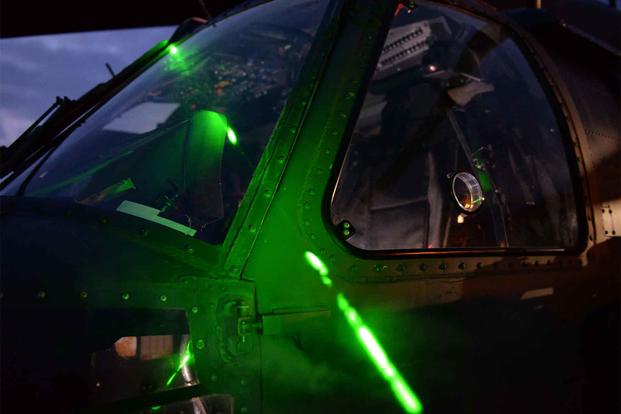
Thousands of pairs of updated protective eyewear will be distributed to Air Force pilots as the service deals with an increase in laser pointer incidents that can distract or even blind military aviators.
The Air Force Life Cycle Management Center’s Human Systems Division, based out of Wright-Patterson Air Force Base in Dayton, Ohio, is starting to field new, upgraded eyewear that can protect against both ballistics and lasers, as well as work for a variety of pilots.
A need for updated eye protection became apparent as the service has seen an increase in people using personal laser pointers — small beam projectors used for everything from classroom presentations to entertaining your pets — to target civilian and military aircraft.
Read Next: VA Plans Outreach to Screen 3 Million More Veterans for Toxic Exposures
According to the latest data from the Federal Aviation Administration, there was a surge in reported laser incidents nationally, with 2021 marking a 41% increase in aircraft laser strikes compared to 2020.
In 2022, there were almost 9,500 incidents reported across the U.S. And so far in 2023, more than 10,300 incidents have been recorded with one month left in the year.
“The consequences of getting lasered without having proper protection could not only prevent the pilot from flying and landing an aircraft safely, but it could also cost them their career,” Capt. Pete Coats, lead program manager for the Human Systems Division’s Aircrew Laser Eye Protection Program, said in a press release this month. “So, our goal is to ensure the right eyewear is available to everyone.”
There are eight variations of the new eyewear, all dependent on what aircraft pilots are flying and what the mission requires, such as separate day and night glasses, ballistics spectacles, and different visors designed to work with night vision goggles, according to the release.
“If flying low and slow or hovering like a helicopter or CV-22 Osprey, aircrew would prefer to have ballistic protection as well as laser protection,” Mark Beer, the Aircrew Laser Eye Protection Program deputy program manager, said in the release. “However, if you’re in a fighter aircraft or flying in a bomber at high altitude, the chances of you needing ballistic protection are not nearly as high.”
The new eyewear will be available for all aircrew, except those flying the F-35 Lightning II and the high-altitude U-2 Dragon Lady reconnaissance aircraft. In total, more than 42,000 upgraded devices are expected to be sent to various Air Force units by 2027.
A vast majority of the laser strike incidents occur at 10,000 feet in the sky, with fewer occurring at 25,000 feet and very few happening above 40,000 feet.
Notably, the small, hand-held lasers can often point a beam at an object from thousands of feet away. When a laser reaches an aircraft cabin or cockpit, it can cause temporary disorientation and blindness or even long-lasting optical damage.
There have been several incidents of lasers being aimed at military aircraft in recent years.
In 2018, the U.S. government protested to China about several incidents in which military planes were targeted with lasers while landing in Djibouti. The Pentagon reported at the time that two Air Force crew members received minor injuries during one incident. Officials requested China to investigate.
In 2019, The Associated Press reported that Air Force officials at North Carolina’s Pope Army Airfield raised concerns following two separate incidents in which planes were targeted with laser pointers. That same year, someone pointed a laser at an Air Force C-17 Globemaster III when it was coming in for a landing at Charlotte International Airport in North Carolina.
Just last month, Aviano Air Base in Italy said in a news release that there had been 13 laser strikes against its aircraft so far in 2023, mostly on the installation’s low-flying HH-60 Pave Hawks.
In the U.S., the FAA has “the authority to impose civil penalties, with fines escalating to $11,000 per violation and $30,800 for multiple incidents,” the Air Force Office of Special Investigations said in a press release.
Individuals caught pointing lasers at civilian or military aircraft and charged criminally can also face fines of as much as $250,000 and up to five years in prison.
Thomas Novelly can be reached at [email protected]. Follow him on X @TomNovelly.
Related: Incidents of Laser Points Aimed at Aircraft Have Spiked, and It Has the Air Force Concerned






